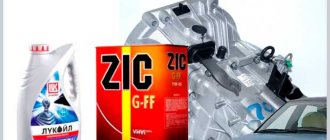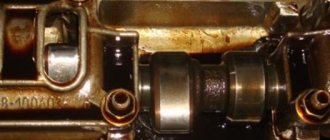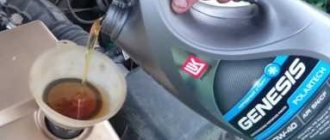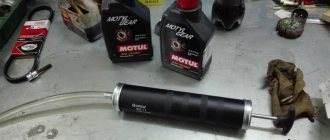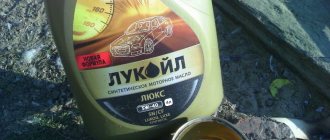- November 6, 2018
- Cars
- Daniil Belousov
A car's engine is its most important part. The functioning of all other components of the vehicle directly depends on the quality of its work. To ensure that the power unit does not malfunction and does not lead to unplanned repairs, you need to use high-quality and proven engine oil. This lubricant is selected depending on the specific vehicle and its engine type. Therefore, it is worth figuring out what kind of oil to pour into the Niva.
Changing the lubricant in these cars is quite a serious undertaking. Before changing the oil, you need to consider some important nuances.
What to pay attention to
When deciding what kind of oil to pour into the Niva engine and car transmission, it is first of all worth noting that it is much easier to replace the lubricant in the gearbox. However, even in this case, the driver must remember several important nuances. For example, the car owner must ensure proper lubrication of all gears of a given unit. The composition should form a thin film on the parts that will protect them from premature wear and scuffing. Thus, depending on what kind of oil is poured into the Niva’s gearbox, you can expect how soon expensive repairs to your favorite car may be required.
Main indicator of liquid
The most important characteristic that you need to pay attention to when choosing a lubricant is its viscosity. If we are talking about oil, the composition must meet the requirements of international quality standards SAE J306. This type of certification was developed in the USA and is generally accepted today. Therefore, first of all, you need to make sure that the selected oil is accompanied by all the necessary documentation or that all the necessary information is indicated on the packaging.
When deciding which oil to pour into Niva axles and other components, you need to evaluate the viscosity of the composition. According to the standards, the letter “W” corresponds to this indicator. As a rule, such a symbol is indicated on seasonal compositions. If there is a letter “W” on the package, this indicates that the liquid can be used in winter. In the absence of this symbol, oil may only be used in positive ambient temperatures.
Based on this, many believe that seasonal lubricants are much better. However, this is not quite true. The fact is that when operating any car, you need to change the oil even before it has exhausted its service life. Therefore, you should not be happy if the composition does not change its characteristics throughout the year.
All-season formulations are also on sale. These are the so-called thickened oils. They have the characteristics of both summer and winter lubricants.
It is equally important to pay attention to the performance properties of oils. In this case there are also certain standards (APIs). Also, when deciding what kind of oil to pour into the Niva, it is worth considering its composition.
Leaks and problems
The higher the mileage of the VAZ Niva, the more problems appear, as in principle with any car. Most often this is due to natural wear and tear of the engine, causing oil to burn. Although the manufacturer allows for a small consumption.
Also interesting: Create music with your own hands — — LiveJournal
There can be many reasons why an engine eats oil. And in each case they can be individual. But, over the years of the model’s existence, we can talk about the most common places where leaks occur.
If the breather is spewing or throwing oil, or if there is oil in the exhaust manifold, this may indicate a serious problem with the oil rings. In this case, you can try decoking with dimexide. But it is better to use special auto chemicals designed for these purposes.
A leak from under the valve cover may be due to a worn gasket. Sometimes simply replacing the gasket does not solve the problem. Since the cover itself may have significant curvature. Therefore, in some cases it will have to be replaced.
A white emulsion in the engine or on the oil filler cap may indicate condensation. This is a common occurrence when temperatures change from minus to plus, mainly in autumn or spring.
But if the emulsion is also observed on the dipstick, then this is already a sign of more serious problems. Most often we can talk about a broken cylinder block gasket. And in rare cases, a cracked cylinder head may be to blame.
Also, with this problem, you can find oil in the expansion tank. Sometimes, simply replacing the gasket is not enough. It may be necessary to grind the head itself, and this is completely different money for repairs.
All this is general information, which may manifest itself differently on each specific vehicle, since everyone’s operating modes are different. The same applies to leak locations; it is impossible to identify the cause from a distance.
Mineral lubricants
Of course, it is logical to assume that the more natural the composition, the better it will be. This fact is confirmed by the unique properties of oils of this type. When using mineral compounds, contacting parts will deteriorate much more slowly. In addition, the so-called natural compounds have excellent anti-corrosion properties.
There are also those car owners who believe that mineral oils are not able to cope with heavy loads. But it is worth considering that during the internal combustion process, many mineral deposits are formed in the engine, which negatively affect the operation of the power unit. Mineral oils may indeed not be able to cope with serious “build-ups” of burnt particles. However, if we are talking about a car with low mileage, then “mineral water” will be quite enough.
Also, when choosing which oil to pour into the Niva transfer case or car engine, it is worth considering that mineral compounds cannot be used in the cold season. This is explained by the fact that this type of lubricant composition begins to thicken greatly at temperatures below -15 degrees. Because of this, the mechanisms cannot function normally. The use of such oils may result in the power unit having to warm up much longer.
Another disadvantage of mineral compositions is that they sometimes fade. Accordingly, the lubricating characteristics of the liquid decrease. This will lead to the components starting to wear out much faster, and fuel consumption will increase. In rare cases, even damage to the power unit may occur. Thus, it is recommended to use mineral-type compounds only at not very low temperatures and for cars with low mileage.
Replacement instructions
It would be logical to find out how much oil is in the VAZ Niva 21214 engine and how much motor fluid is required to purchase. If we talk about the volume of liquid being filled, then for the Niva engine it is 3.75 liters. The actual volume of oil in the engine is usually less than that indicated in the vehicle's data sheet. This is due to the fact that when draining the waste, some of the oil still remains in the system. It is almost impossible to clean the engine 100% on your own. You should take plenty of oil, but not much. It is better to take a 5 liter canister of high-quality lubricant. This will allow you to fill the full volume into the crankcase, plus periodically add it as the level changes.
Scheduled oil changes in Chevy Niva and VAZ Niva 21214 engines are performed at approximately the same frequency. The procedure itself is standard and includes compliance with some general rules and safety measures.
To work, you will need to collect some materials and tools. This list includes:
- fresh motor oil in the right quantity;
- an empty container where the waste will be drained;
- funnel for filling;
- fuel filter;
- 12mm hex or 17mm wrench;
- puller for the oil filter (you can do without it);
- inspection hole;
- rags;
- lighting;
- overalls (gloves, closed shoes, thick clothing).
If you have everything ready, you can start working. Be sure to follow the instructions step by step, do not rush and do not try to unscrew or tighten anything by applying great force. Otherwise, you risk breaking some parts, which will lead to more expensive repairs. We begin the procedure for changing the engine oil, changing the filter at the same time.
- Place the car on an inspection hole to have easy access to the bottom where the oil pan is located. The engine should be warmed up first so that the oil acquires a more liquid structure and can easily drain from the sump.
- If you warmed up the engine at idle, wait a few minutes so that all the liquid drains down. You can still unscrew the filler plug in the engine compartment. This will allow the oil to come out from below faster.
- Carefully unscrew the drain plug. It comes in different types, so you will need a hexagon or wrench to dismantle it. Before you begin to unscrew the cap, place an empty container under it. Unscrew completely and let the oil drain. This will take about 10 – 15 minutes. Therefore, at the same time, work on the oil filter.
- If the oil comes out very dirty, then a lot of debris, chips and dirt will remain in the system. In this condition, it is recommended to flush the engine. To do this, use special additives, flushing mixtures or fresh oil.
- There are additives that you simply add to the filler neck while the old grease is still there, start the engine and let it run for a few minutes. Then they are jammed and everything is removed from the pan.
- The option with flushing oil or regular fresh engine oil looks different. First, the old fluid is drained, then the drain plug is closed, fresh oil is added, the engine is turned on and it runs at idle speed for 5 - 10 minutes. Now the pan plug is unscrewed again and drained. If the engine is heavily dirty, it is recommended to repeat the procedure 2–3 times. This takes a lot of oil, but it gives the engine new life.
- Only after complete washing is the old filter removed and a new one installed in its place. The filter is unscrewed with a puller, manually or with an improvised tool. The puller is the most convenient, but is not always available to the car owner. Be careful not to damage adjacent pipes and wiring. For safety reasons, it is better to remove the negative terminal from the battery.
- Clean the holes for the drain plug and the filter if there is dirt there. Otherwise, they may get into the fresh motor fluid.
- Before reinstallation, check the plug gasket and replace it if necessary. The filter seal is lubricated with oil, and engine fluid is filled to 50% of the volume of the new filter. Now you can install them in place.
- Make sure that the filter and plug are firmly in place and that there are no leaks through them.
- We move on to the engine compartment, where we use a funnel to pour fresh composition through the filler neck. Fill in about 3.5 liters first, since some of the oil remains in the system. Close the lid and run the engine at idle speed for 2 - 3 minutes.
- Turn off the engine and let the oil drain. Take the dipstick and check the level. A trace of the oil film should remain between o and “Max”. If the level is closer to the minimum value, open the lid again, add a little more lubricant and repeat the procedure.
When you start the car, the oil pressure light will come on. It's not scary, it always happens. The indicator will go out after a few seconds. Over the next few days, monitor how your Niva behaves. Check under the car for traces of fresh oil. Leaks may occur due to a poorly installed filter or drain plug. Tighten the connections and recheck the level.
Owners of the VAZ Niva 21214 car are advised to periodically monitor the oil level, add it as needed and react promptly if the liquid suddenly changes color, becomes cloudy, its consumption increases or the engine overheats. Signs like these indicate more than just a leak. There is a possibility that you chose the wrong oil or there are problems with the engine that cannot be eliminated by simply replacing consumables. You will need to seek qualified help.
Synthetic oils
When deciding what oil to pour into the Niva, many come to the conclusion that artificial compounds have better characteristics. Synthetic formulations may actually be more beneficial. During the development of such oils, complex chemical processes are used, thanks to which the characteristics of the fluid can be adjusted.
If we talk about the advantages of synthetic compounds, it is worth considering that they remain resistant to thermal changes much longer and retain their original characteristics longer. In addition, lubricating fluids of this type contain additional additives that significantly improve the performance of the oils. This allows you to no longer worry about wear and tear on the power unit. At the same time, synthetic compounds will not thicken in winter. Therefore, the engine will start without delay.
Synthetic oils begin to freeze only at -60 degrees. They do not oxidize or evaporate. At the same time, their lubricating index is quite high. In this case, you can actually make replacements much less frequently.
Transmission
The Niva 4x4 transmission system has the following filling volumes:
- transfer case - 0.79 l;
- gearbox - 1.6 l;
- rear axle - gearbox - 1.3 l;
- front axle - crankcase - 1.15 l;
- steering column - crankcase - 0.18-0.2 l.
| Lower limit of ambient temperature, °C | -15 | -25 | -25 | -30 | -40 |
| Upper limit of ambient temperature, °C | 45 | 45 | 35 | 45 | 35 |
| SAE lubricant viscosity grade | 85W-90 | 80W-90 | 80W-85 | 75W-90 | 75W-80 75W-85 |
As stated in the operating instructions, transmission lubricants need to be changed once every 30 thousand km. mileage At the same time, replacement is not provided for in the steering mechanism housing, only an addition through the top plug. The “native” oil for Zhiguli transmission units is considered to be TAD17I.
Transmission oils have good penetrating ability. Therefore, poorly clamped plugs and worn gaskets of units begin to gradually leak lubricant. In such situations, it is allowed to add oil of the same viscosity class and, preferably, the same manufacturer. If you do not top up during a leak, the lubricant level in the unit will decrease, which will lead to accelerated wear of expensive mechanisms.
Semi-synthetic compounds
When wondering what kind of oil to pour into a Chevrolet Niva, many are confused, since this car model is a compact SUV. If we talk about semi-synthetic oils, they have the characteristics of the two types described above. They contain 70% synthetic components and 30% mineral ones.
Such compositions are considered optimal for those cars that have a fairly high mileage, but at the same time they have been filled with “synthetics” for too long. Semi-synthetic compounds are changed with varying regularity. This depends on numerous factors. It is important to consider how often the vehicle is used, the condition of the vehicle's powertrain, etc.
However, no matter what kind of oil is poured into the Niva, you must always remember that the more often the lubricant composition is changed, the longer the vehicle will last. Based on all this, we can identify several liquids that are most popular among car owners.
"Lukoil Lux 10W-40"
Many, when choosing which oil to pour into the Niva, give preference to this particular composition. The lubricating fluid of this brand meets all the necessary requirements. Car owners trust the quality of these compounds, since this manufacturer has long established itself in the market.
"Lukoil Lux 10W-40" has a positive effect on the power unit and helps conserve energy. Many noted that these compounds help reduce fuel consumption. According to tests, this oil performs well in various extreme conditions.
Model description
For the domestic market, the appearance of an all-terrain vehicle was a real breakthrough.
The VAZ-21214 model, which later received the name “Lada 4×4”, and is popularly called “Niva”, is a modification of the VAZ-2121 car. This four-seater passenger car, with increased cross-country ability, belongs to the class of SUVs. It is equipped with all-wheel drive, a five-speed gearbox, a transfer case, a locked center differential, has fairly good ground clearance (22 cm), a short wheelbase and small body overhangs.
The car is capable of accelerating to a speed of 142 km/h, fuel consumption (AI-92) is 10.8 l/100 km (combined cycle).
The Lada injection power unit has:
- power 80 hp;
- four cylinders (two valves each);
- volume 1.7 l;
- torque 127.5 Nm at 5200 rpm;
- distributed fuel injection (electronically controlled).
Over the years, the engine has been modernized to Euro standards. So, since 2011, it began to comply with Euro-4 toxicity standards (models for the foreign market - Euro-5).
The guaranteed resource of the power unit is 80 thousand km, but usually up to 150 thousand km major repairs are not required.
"Dolphin Industry"
Car owners highlight the products of this company (or rather, the compositions “Lux Hit” and “Lux Best”), since only modern technologies and the latest developments are used in the production process of lubricating fluids.
If, when deciding which oil to pour into the Chevrolet Niva engine, you chose this particular composition, then you should pay attention to the fact that it contains molybdenum. This component causes mixed reviews, but most car owners note the excellent properties of this additive. It is believed that molybdenum reliably preserves the power unit and reduces fuel consumption.
"Rosneft"
You can also find products from this popular manufacturer on the market. If, when choosing which oil to pour into a Chevrolet Niva engine, the car owner decides to purchase this particular composition, then he can be sure that the liquid uses the newest and most effective additives that will preserve the power unit longer.
It is also worth noting that Rosneft products are suitable if the vehicle is operated in harsh conditions or in situations of serious temperature changes. Oil from this manufacturer is characterized by low consumption.
Budget options
Cheap options are not always bad. There is also a worthy alternative to expensive motor products.
Rosneft Maximum oil is a good option for a semi-synthetic product for very modest money. The manufacturer has been present on the motor oil market for a long time and has fairly good reviews. Which engine oil is better for Chevrolet Niva: synthetic, mineral or semi-synthetic? Everyone will decide for themselves, based on the operating conditions of the car and the size of the budget allocated for car maintenance.
LUKOIL Standard is a budget mineral oil, which can probably be called a leader in the segment. And don’t forget about its natural composition.
"Niva Chevrolet": what oil to pour into a manual gearbox
This car is equipped with a manual transmission. Therefore, when using low-quality lubricants, car owners often notice the appearance of noise in the manual transmission. If the problem is ignored, repairs may be required in the future.
However, if you use Lukoil 10W-30, then according to consumer reviews, the noise disappears and the car starts to work better.
Features of choosing transmission oil and lubricants for the engine
First of all, it is worth noting that gearbox fluids, even if they are “scorched,” cannot have such a destructive effect. If you choose a low-quality composition for the engine, the consequences will be much more serious.
It is also worth considering that everything depends on the specific car. If one car owner praises the composition that he has been using for a long time for a Mercedes, this does not mean that the same oil is suitable for a Niva. As a rule, it becomes possible to understand that a particular composition is not suitable after 5000 km traveled by the car.
An important point is how often the composition is replaced. For example, if the car is used as a towing vehicle, often drives off-road and operates the power unit in the most difficult conditions, then the lubricant needs to be changed much more often.
How to change the oil in a car correctly
If we are talking about the Chevrolet Niva, the manufacturer recommends changing the oil every 15,000 km. In this case, manipulations must be carried out in accordance with the clear recommendations of specialists.
First of all, you need to place the car on a viewing hole or lift. When the car is secured and cannot accidentally move, you can remove the engine protective cover located at the bottom. After this, you need to place a container under the hole (a 5-liter canister is best) and unscrew the drain plug. At the next stage, you need to be patient and wait until the old oil drains into the container. Time can be put to good use if you start replacing the filter at this time. It needs to be unscrewed. After this, new oil is poured into the new filter.
When the fluid is renewed, it is necessary to install the element in place of the old one. The next step is to replace the seal. After this, you can tighten the drain hole and return the protection to the engine.
Next, you need to open the neck and pour about 3.5 liters of lubricant into it. That's not all.
After all the manipulations, you need to start the car engine and wait until the power unit warms up. When a little oil is gone, add a little more compound and leave the engine running for another 10 minutes. After this, the oil level is checked again (it is best to use a special dipstick). If there is not enough liquid, you need to add it.
Replacement frequency
It's no secret how the engine oil in a car is changed. First, the engine should be warmed up to operating temperature, then unscrew the filler neck, remove the oil filter, and unscrew the drain plug. After the oil has completely drained, we change the filter, and then you can only pour in new oil, having first tightened the plug.
The frequency of oil changes on Niva is 10,000 km
Many car enthusiasts have a question: “Is it worth changing the filter after this procedure?” The answer will be individual for everyone. In general, a standard oil filter is designed for 10–12 thousand kilometers, so it easily lasts two fluid changes. But, if you have the funds, a replacement will not be superfluous. If you change the filter every 5-6 thousand km, the engine will be provided with a long life. So, decide this issue based on your financial capabilities.

